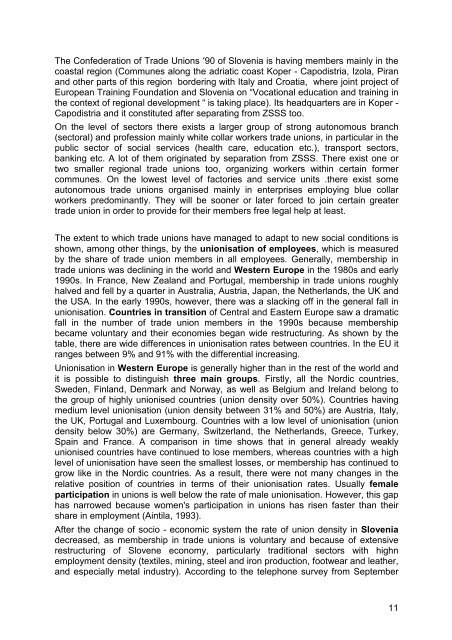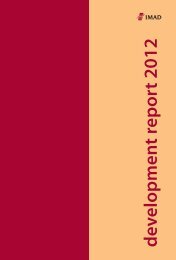The Development of New Industrial Relations in Slovenia - UMAR
The Development of New Industrial Relations in Slovenia - UMAR
The Development of New Industrial Relations in Slovenia - UMAR
Create successful ePaper yourself
Turn your PDF publications into a flip-book with our unique Google optimized e-Paper software.
<strong>The</strong> Confederation <strong>of</strong> Trade Unions ′90 <strong>of</strong> <strong>Slovenia</strong> is hav<strong>in</strong>g members ma<strong>in</strong>ly <strong>in</strong> the<br />
coastal region (Communes along the adriatic coast Koper - Capodistria, Izola, Piran<br />
and other parts <strong>of</strong> this region border<strong>in</strong>g with Italy and Croatia, where jo<strong>in</strong>t project <strong>of</strong><br />
European Tra<strong>in</strong><strong>in</strong>g Foundation and <strong>Slovenia</strong> on “Vocational education and tra<strong>in</strong><strong>in</strong>g <strong>in</strong><br />
the context <strong>of</strong> regional development “ is tak<strong>in</strong>g place). Its headquarters are <strong>in</strong> Koper -<br />
Capodistria and it constituted after separat<strong>in</strong>g from ZSSS too.<br />
On the level <strong>of</strong> sectors there exists a larger group <strong>of</strong> strong autonomous branch<br />
(sectoral) and pr<strong>of</strong>ession ma<strong>in</strong>ly white collar workers trade unions, <strong>in</strong> particular <strong>in</strong> the<br />
public sector <strong>of</strong> social services (health care, education etc.), transport sectors,<br />
bank<strong>in</strong>g etc. A lot <strong>of</strong> them orig<strong>in</strong>ated by separation from ZSSS. <strong>The</strong>re exist one or<br />
two smaller regional trade unions too, organiz<strong>in</strong>g workers with<strong>in</strong> certa<strong>in</strong> former<br />
communes. On the lowest level <strong>of</strong> factories and service units .there exist some<br />
autonomous trade unions organised ma<strong>in</strong>ly <strong>in</strong> enterprises employ<strong>in</strong>g blue collar<br />
workers predom<strong>in</strong>antly. <strong>The</strong>y will be sooner or later forced to jo<strong>in</strong> certa<strong>in</strong> greater<br />
trade union <strong>in</strong> order to provide for their members free legal help at least.<br />
<strong>The</strong> extent to which trade unions have managed to adapt to new social conditions is<br />
shown, among other th<strong>in</strong>gs, by the unionisation <strong>of</strong> employees, which is measured<br />
by the share <strong>of</strong> trade union members <strong>in</strong> all employees. Generally, membership <strong>in</strong><br />
trade unions was decl<strong>in</strong><strong>in</strong>g <strong>in</strong> the world and Western Europe <strong>in</strong> the 1980s and early<br />
1990s. In France, <strong>New</strong> Zealand and Portugal, membership <strong>in</strong> trade unions roughly<br />
halved and fell by a quarter <strong>in</strong> Australia, Austria, Japan, the Netherlands, the UK and<br />
the USA. In the early 1990s, however, there was a slack<strong>in</strong>g <strong>of</strong>f <strong>in</strong> the general fall <strong>in</strong><br />
unionisation. Countries <strong>in</strong> transition <strong>of</strong> Central and Eastern Europe saw a dramatic<br />
fall <strong>in</strong> the number <strong>of</strong> trade union members <strong>in</strong> the 1990s because membership<br />
became voluntary and their economies began wide restructur<strong>in</strong>g. As shown by the<br />
table, there are wide differences <strong>in</strong> unionisation rates between countries. In the EU it<br />
ranges between 9% and 91% with the differential <strong>in</strong>creas<strong>in</strong>g.<br />
Unionisation <strong>in</strong> Western Europe is generally higher than <strong>in</strong> the rest <strong>of</strong> the world and<br />
it is possible to dist<strong>in</strong>guish three ma<strong>in</strong> groups. Firstly, all the Nordic countries,<br />
Sweden, F<strong>in</strong>land, Denmark and Norway, as well as Belgium and Ireland belong to<br />
the group <strong>of</strong> highly unionised countries (union density over 50%). Countries hav<strong>in</strong>g<br />
medium level unionisation (union density between 31% and 50%) are Austria, Italy,<br />
the UK, Portugal and Luxembourg. Countries with a low level <strong>of</strong> unionisation (union<br />
density below 30%) are Germany, Switzerland, the Netherlands, Greece, Turkey,<br />
Spa<strong>in</strong> and France. A comparison <strong>in</strong> time shows that <strong>in</strong> general already weakly<br />
unionised countries have cont<strong>in</strong>ued to lose members, whereas countries with a high<br />
level <strong>of</strong> unionisation have seen the smallest losses, or membership has cont<strong>in</strong>ued to<br />
grow like <strong>in</strong> the Nordic countries. As a result, there were not many changes <strong>in</strong> the<br />
relative position <strong>of</strong> countries <strong>in</strong> terms <strong>of</strong> their unionisation rates. Usually female<br />
participation <strong>in</strong> unions is well below the rate <strong>of</strong> male unionisation. However, this gap<br />
has narrowed because women's participation <strong>in</strong> unions has risen faster than their<br />
share <strong>in</strong> employment (A<strong>in</strong>tila, 1993).<br />
After the change <strong>of</strong> socio - economic system the rate <strong>of</strong> union density <strong>in</strong> <strong>Slovenia</strong><br />
decreased, as membership <strong>in</strong> trade unions is voluntary and because <strong>of</strong> extensive<br />
restructur<strong>in</strong>g <strong>of</strong> Slovene economy, particularly traditional sectors with highn<br />
employment density (textiles, m<strong>in</strong><strong>in</strong>g, steel and iron production, footwear and leather,<br />
and especially metal <strong>in</strong>dustry). Accord<strong>in</strong>g to the telephone survey from September<br />
11
















